1920- Centre Heads to the Big-Time
After the Harvard game was announced for October 23 on the upcoming 1920 season, Centre could begin working in earnest on the rest of the schedule.
It was never definitely documented, but it was understood that Harvard and Howard Reynolds wanted and actually expected Centre to arrive in Cambridge undefeated when the Colonels headed east.
We need to clear up a little geographical issue when discussing Harvard and Cambridge. Harvard’s campus primarily is in Cambridge, on the north side of the Charles River, several miles west of downtown Boston. Harvard Stadium, built in 1903, is located just south across the Charles, on Soldiers Field, in the Allston neighborhood and remains there to this day. However, for clarity, we’ll just utilize Cambridge when referring to any reference about Harvard.
Harvard and Reynolds had a lot invested in the game. Harvard felt that Centre had earned a slot on the Crimson schedule by its undefeated season and felt almost honor-bound to schedule the Colonels. It also was felt by some that it would look like the college was shying away from Centre’s success if it wouldn't be willing to accept the challenge. Reynolds felt that if the two schools met on the gridiron, it would be a big step toward his promotion of intersectional games in helping determine a true “National Champion.”
Both knew that if the game attracted a sell-out crowd, a huge payout would result. Harvard’s games with Yale and Princeton were played to capacity crowds. Others, despite the success of the Crimson over the years, rarely taxed the capacity of the big horseshoe which held 42,000 at the time if the end zone temporary seats weren't erected.
However, if Centre lost an early game prior to coming east, the whole event would lose its luster. There would be no shot of the game being a factor in determining the best team in the nation, and the possibility of drawing a huge crowd would be remote. Certainly, Centre’s people understood that as the first three games of 1920 were penned in.
Oct. 2 Centre Morris Harvey Danville, Ky.
Oct. 9 Centre Howard Danville, Ky.
Oct. 16 Centre Transylvania Danville, Ky.
After the first “warm-up” games, the rest of the schedule continued with Harvard and ended with the traditional Thanksgiving foe, Georgetown.
Oct. 23 Centre Harvard Cambridge, Ma.
Oct. 30 Centre Georgia Tech Atlanta, Ga.
Nov. 6 Centre DePauw Indianapolis. In.
Nov. 13 Centre Kentucky Lexington, Ky.
Nov. 20 Centre Virginia Tech Louisville, Ky.
Nov. 25 Centre Georgetown Danville, Ky.
Chief Myers put many members of the Colonels to work during the summer promoting the chautauqua shows that his company had booked. It was an especially perfect type of job for someone like Bo. The now All-American could parlay his national fame to fit in with his duties as he traveled around the country.
Local citizens would hear that Bo- “Bo McMillin, the All-American”- was going to be in town to put up some posters and to speak about the upcoming attractions heading to their town. The Centre star didn’t have to nail up any posters. There were always young men anxious to help him out, and every local civic group and church was eager to have him speak, to be able to say that they’d been in the presence of the “greatest football player in the whole country!”
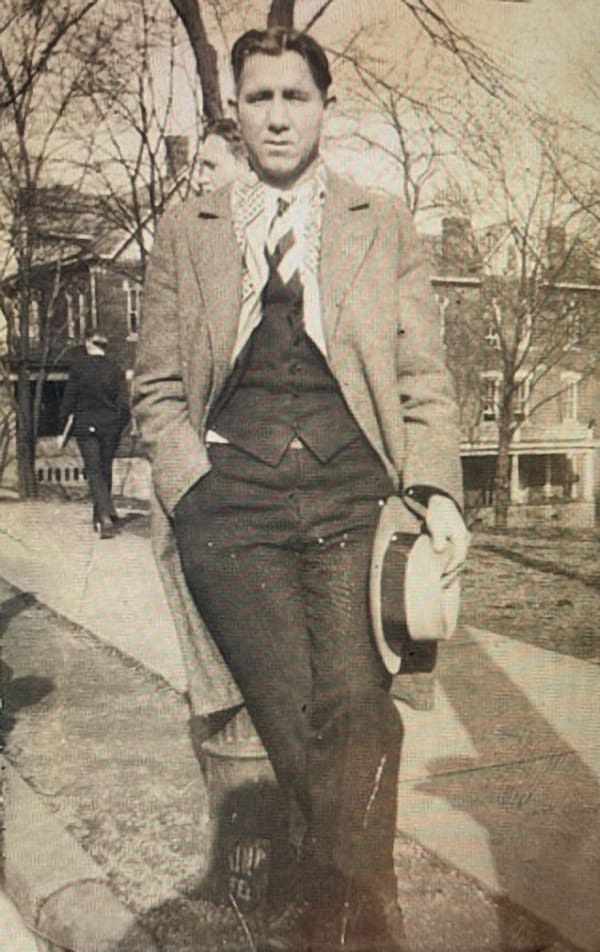
Bo
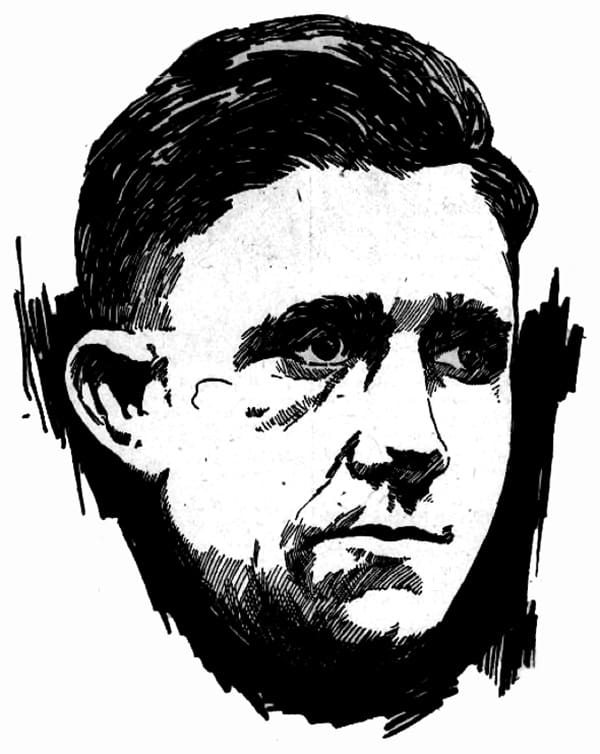
Bo McMillin, "the greatest player in the whole country!"
Bo later said that if there had been one thing that had best prepared him for life after college, it was the experience and confidence that he gained in dealing as an ambassador of the Chief’s chautauqua-booking company.
"Boys, let's get busy," was the first thing Chief Myers said on the opening day of practice for the 1920 season. "We can't lose a minute between now and October 23. It's going to be a mighty hard season, and it's up to every player to keep in the best condition and report regularly and on time for practice."
Myers stated that when all of the members returned, and with the new men showing up who couldn't join the team until classes actually began because of S.I.A.A. restrictions, he expected 60 men to try out for football.
"We have good men coming in from Seattle to Long Island, with Kentucky in the lead and Texas coming on strong. Boys, I know we'll lay all of their heads down. We'll miss nobody. They'll all go Titanic," a reference to the 1912 tragedy in the North Atlantic when over 1500 people perished when the great ship hit an iceberg and sank.
What a difference a great season can make in a school's football prospects. Centre had 211 students during the 1920-21 academic year. There was a huge freshman class ( for Centre ) arriving on campus. Where there had been 76 newcomers in 1919, there were now 99, an increase of 30%.
THE STUDENT BODY FOR 1920-21
Seniors | 25 |
Juniors | 36 |
Sophomores | 51 |
Freshmen | 99 |
Total | 211 |
Centre had been hard-pressed to put 22 men on the practice field in order to scrimmage just a few short years ago. Now, nearly 30% of the young men attending the college wanted to be members of the Gold and White.
Interest was such that the two local papers announced daily who had gotten in from the summer hiatus and who was not yet in Danville.
Gus King will arrive on the morning train on the 8th.
Chick Murphy and Lefty Whitnell sent a wire that they couldn't get to Danville until the 13th.
Big Sully Montgomery and Bill James can't get away from their jobs down in Texas until the 21st.
One interesting route of travel to Centre was the canoe trip that an incoming freshman, Stanley Robb, took from Pittsburgh. Robb embarked on the Ohio River from his hometown and paddled down-river for several days until he came to the mouth of the Kentucky River at Carrollton, Kentucky where he took a left, heading south, upsteam. After navigating up the Kentucky, he entered the Dix River and finally pulled his trusty little boat out of the water and walked the few miles into Danville.
Twenty freshmen were introduced at the first chapel who were going out for football.

Centre had obligatory chapel at the First Presbyterian Church on West Main adjacent to the campus
Most of the regulars from the 1919 season were returning, with only Allen Davis, Matty Bell, and Howard van Antwerp lost to graduation.
Two great players who had been on the campus during 1919, but weren't eligible to play, were Hump Tanner and Tom Bartlett from Owensboro. Hump, a little fireplug, and "Long Tom," a great back and defensive man, would play vital roles in the upcoming campaign. ( Hump had played for Colorado in 1918. He played one game in 1919 but was then ruled to be ineligible and sat out the rest of the season. Bartlett had played at Missouri and was also declared not to be eligible in 1919. )

John Porter "Hump" Tanner

Tom Bartlett
Centre's "Press Day" in the past was attended by the two local papers, the "Advocate" and "Messenger," with perhaps a reporter, if one could be spared, coming over from one of Lexington's papers. Certainly things had changed. All of the weekly papers from Central Kentucky sent their representatives. The wire services were represented by the NEA. The Lexington "Leader" and "Herald" had their men in Danville. The Louisville papers, the "Courier-Journal," the "Times," and the "Herald," each had their reporters interviewing the Colonels and taking pictures. Naturally, Danville's "Advocate" and "Messenger" showed up.
Ed Danforth of the Atlanta "Journal" took the train up to spend the day with the team. Each year, Danforth made the circuit to various colleges to size up their prospects for the upcoming football season. He hadn't come to Danville previously, but now the little school was gaining such fame that he wanted to let his readers know exactly what they could expect from this previously unknown program which had reached such heights as to attract the attention of mighty Harvard.
The halo of the supernatural that has surrounded the Centre team has been dispelled as far as I am concerned. They unite in prayer before every game, but otherwise this football team that plunged Danville and the college into a flood of pleasurable publicity last year by scoring 485 points to their opponents 23 is composed of human beings and not cantors or holy rollers. In fact, the only difference between Centre College and any other team in the South is about five touchdowns.
Twenty-eight men followed Captain McMillin through the gate of Cheek Field for the first practice of the 1920 season. ( Several returning regulars were still to report, and freshmen couldn't begin practice until the official opening of the school. )
The crew trotted around the field and pulled up huffing and puffing, listened to McMillin caution them against straining themselves, did a few starts from a charging position, went through some setting up exercises, circled the field several times more, straggled into the gym, found the water cold, complained about the lack of towels and uncomfortable shoes, and foregathered again down in front of the pool hall, just like regular guys everywhere.
Clever press agenting and the mystery that surrounds the overnight champions have given the public a distorted view of this football team. One comes expecting to see men with pale, drawn faces filled with holy enthusiasm and eyes lit with the lurid light of the zealot fighting like crusaders of old. But instead, one finds a normal, clean-cut gang of college boys who smoke cigarettes in the summer, but not during the season, hang out around cigar stands when off duty, and are out of uniform if they leave that frat pin at home on the bureau.
Charlie Moran was not here on Monday. He is still wearing the blue serge of a National League umpire and won't take over the directorial reins until September 15. Uncle Charlie has coached the Centre team since after the DePauw game in 1917, and they have not lost since.
Talk about personal attention! These fighting, crying, praying Colonels get more petting and pampering from Charlie Moran than any string of trotters on the Grand Circuit receive from a veteran trainer. Not that Moran is easy on the boys-quite to the contrary. Bo McMillin has been jerked out of a game for missing one tackle. Uncle Charlie takes the boys fast, but he looks after their physical well-being with his own eyes and hands.
Moran has a sewing machine which he operates in person. He sews up rips in pants and rents in jerseys. He repairs their shoes and smooths out rough places on the inner soles. And before every game, he bandages their ankles, arms and ribs. As a result, he loses few men through injuries. The famous Bo has never been out of play but three minutes due to "injury," and even then, it was only because he was so hoarse that he couldn't call signals.
A full game scrimmage was scheduled for September 25 with Uncle Charlie having been on the campus for the last four days. Even though it was just a glorified practice, there was a large crowd which wanted to see this edition of the Colonels in action. Bo was to quarterback the newcomers and Hump Tanner the regulars. Bo's value was further demonstrated by the fact that his relatively inexperienced group was able to hold their own while he ran their plays, but when he was switched to the veterans, he led a determined drive which marched the ball down for a quick score, highlighted by his 50-yard sprint.
Fans on the sidelines noted that the veterans "whole countenance" changed when Bo switched to their team.
After the scrimmage, Uncle Charlie announced that from now on, until after the Harvard game, practices would be closed to "strangers." It was obvious that Centre wanted to perfect its attack away from the prying eyes of any scouts who may wish to size up the Colonels, especially if their reports may be sent back to Harvard, or even to Georgia Tech.
Thad McDonnell, one of the Fort Worth North Side boys, decided that he wasn't good enough to play and became the team's manager. He was asked by the two local papers to report on any injuries or to provide any other information which could be related to the team's fans. Fortunately, the only casualty that he reported was the shoulder injury suffered by Terry Snowday which kept him out of any of the drills requiring contact for much of September.
McDonnell related an interesting tidbit about Chick Murphy which was reported in both papers.
Murph, fleet little star, stepped out in a brand new pair of shoes. They had to be made to order because Chick's feet are so small. They are size 4½. He took a couple of laps in them and pronounced them to be fine.
The local papers also felt it necessary to carry any bit of news that they could pick up over the wire services about Harvard. The "Messenger" ran a front page story on September 20 under the headline:
HARVARD OPENS SEASON THIS SATURDAY
The story related that the Crimson coaches were satisfied with their team's progress and expected a big season. It was revealed that the line would average 185 pounds in the opener with Holy Cross on September 24.
The day before Harvard's first game, H.C. King, district passenger agent for the Southern Railroad, came down from Lexington to complete arrangements for a special train to take the team and fans to the October 23 game in Cambridge. The round trip ticket was to cost $110.00 which would include not only the train fare, but the Pullman tariff and all meals.
( On a regularly scheduled, non-special, passenger train of the day, there was a fare charged just for the transportation to a destination. If someone wanted to ride in a sleeper car, a separate tariff was paid to the Pullman Company which owned and staffed the cars. The railroad operated the dining cars even though they were built by Pullman and charged for any meals served.)
The "Harvard Special" was going to be parked in the South Boston Terminal yard upon arrival. The train would be kept intact until the return trip so that those who wished could return to their car each night and avoid any extra lodging charges while in Boston.
The team's headquarters was going to be at the Arlington Hotel at Tremont and Arlington, just a short cab ride from South Station, or a walk of several blocks.
Shortly after the arrangements for the "Special" were completed, Chief Myers received the welcome news that Harvard was holding 600 seats for Centre's fans on the 50-yard line, seats which were considered the prime location in Harvard Stadium. The ticket's price was $2.00, which put to rest the rumor that an exorbitant amount was going to be charged.
Meanwhile, even though all eyes were on Harvard, one month away, there was the matter of three games to be played before the momentous journey to the East. The Colonels knew that much of the luster would be removed if they didn't arrive in Cambridge undefeated. If they could sweep and go 3-0, they would be riding a 22-game winning streak when they went up against the Crimson.
Likewise, if Harvard opened 4-0, their squad wouldn't have lost during their last 14 contests, the only blemish being the 10-10 tie with Princeton on the previous November 8.
Army was quoted as saying, "We're cheering for Harvard. We want to be the team that hopefully hands them their first defeat since 1916."
( It must be remembered that Harvard didn't consider the war years' records as "official," and therefore didn't include any games during 1917-18 when compiling statistics. )
As I related in the introduction, from time to time, you are going to hear from my father’s recollections in boldface.
I first met Red Roberts in the spring of 1920. My brother Howard and I were visiting "Cousin Ella" Welsh who lived in Danville and we had taken the L&N train over from Elizabethtown to Junction City where her chauffeur picked us up to drive us to Danville. We called her "Cousin Ella" because she was the first cousin of my grandfather, Samuel Richard Robertson.
She lived in a big home right across from Old Centre which later became the residence of Centre's president after she died in 1937. Her husband was George Welsh ( 1845-1924 ) who was a founder of Farmers Bank in Danville plus the co-owner of the biggest department store, Welsh and Wiseman, at the corner of 3rd and West Main Street. He was also on Centre's board for many years, from 1890, when he succeeded his father, until his death.

Centre benefactor, George Welsh. The 1917 "Old Centre" yearbook was dedicated to him.
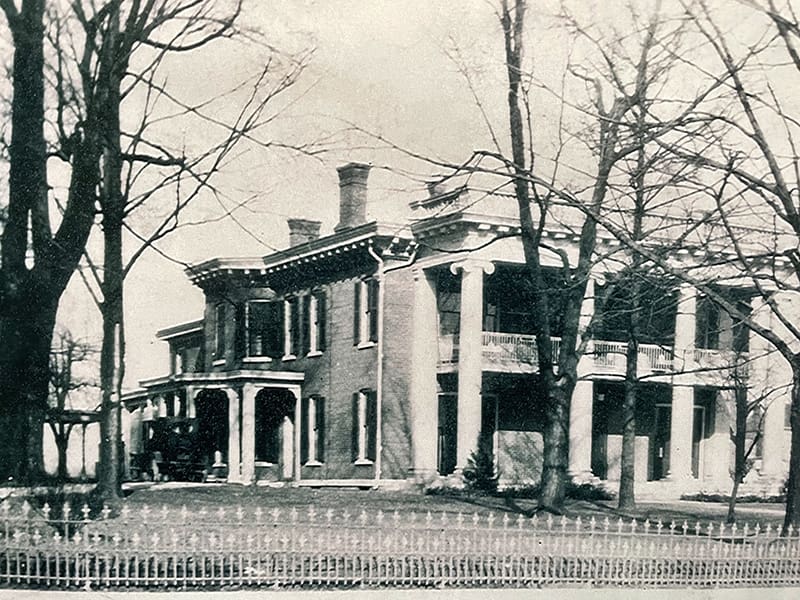
Danville home of Red Robertson's "Cousin Ella" and George Welsh across from Old Centre which became the home of Centre's president after her death in 1937. The Greek Revival front portico was added to the 1853 Italianate home in the early 1900's by the Welshes. The impressive mansion was a gift to Ella and George Welsh in 1877 by Samuel Beale Thomas, Ella's father, and Red Robertson's great, great uncle.
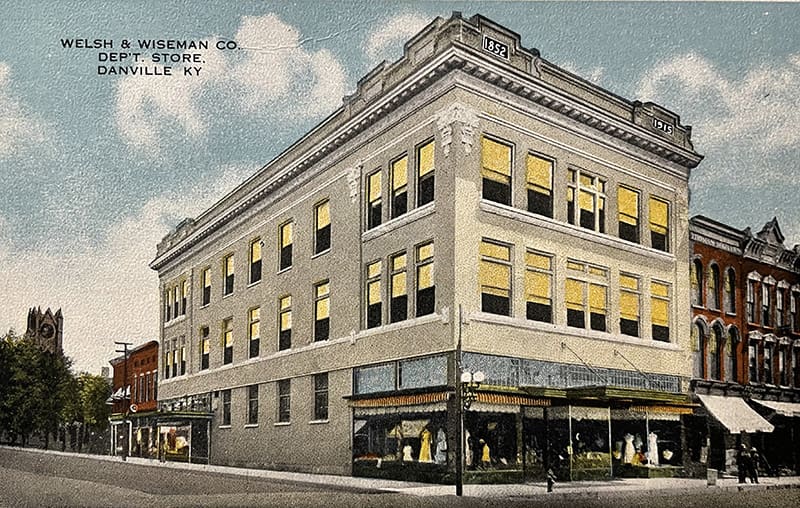
George Welsh owned the finest store in Danville along with Guy Wiseman. It was located on the corner of 3rd Street and West Main. Both Welsh and Wiseman were major contributors to Centre with Welsh being on the board for decades and Wiseman leaving the college $400,000 upon his death in 1939 which would be over $6,000,000 in today's valuation. There is a dorm named for him, Wiseman Hall, behind Old Centre.

George Welsh died during Red Robertson's junior year. The funeral, which he attended, was said to be the largest ever held in Danville. "Cousin Ella" died some 13 years later.
Not only was George Welsh well-to-do, but "Cousin Ella" was the daughter of Samuel Beale Thomas ( 1811-1874 ), one of the founders of the L&N Railroad along with Elizabethtown's First National Bank and the brother of my great-grandfather, Joshua Howard Thomas, M.D.

Samuel Beale Thomas, "Elizabethtown's millionaire"
People called him "Elizabethtown's millionaire" and he actually was because he not only gave the house where we were visiting in Danville to "Cousin Ella" but also built a home in E-town for his other daughter, our "Cousin Mary," which was the finest home there when he built it in 1872 for her and her husband, Colonel James Brown Payne.
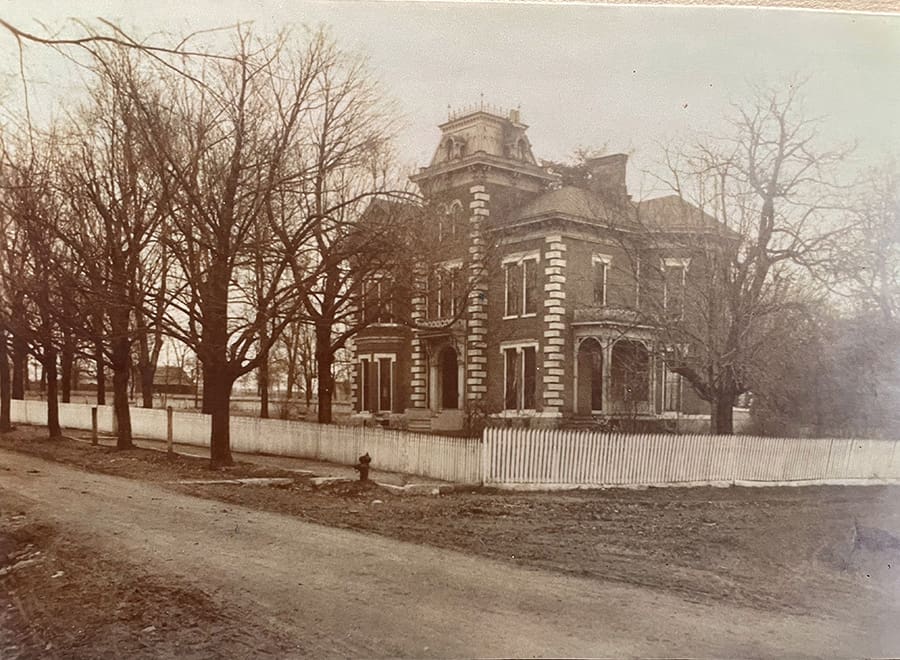
Elizabethtown, Kentucky home built by Samuel Thomas as gift to Mary, his daughter, known as "Cousin Mary" to Red Robertson
Anyway, some of the players were over on the football field throwing a ball around and we went over to watch. One of them asked me what my name was and I said Red Robertson which made him laugh and he hollered over to this big guy to come over and introduced me to him and told him what my name was.
That's how I first met Red Roberts who later loved to take me up to people after I got to Centre in 1921 and would ask me to tell them who I was and I'd say, "I'm Red Robertson." I'd emphasize the "son" and Red would always get a kick about how they'd react. They'd look at Red and he'd just nod and smile.
Later that year in the summer, Howard and I were in Louisville visiting another relative, my Aunt Mary Robertson Wintersmith, who was my father's sister and had married my uncle Theodore Wintersmith who had a company named Wintersmith Chemical Company which made something called Wintersmith's Tonic which contained quinine and was effective against malaria, which was pretty prevalent in those days, particularly in the South. His company was very successful and he did quite well, and even better when prohibition became the law of the land, because they upped the alcohol to 10% which made it quite popular because you could buy it legally as a medicine. A lot of people decided they needed to PREVENT malaria, even in the winter when there weren’t any malaria-carrying mosquitoes around.
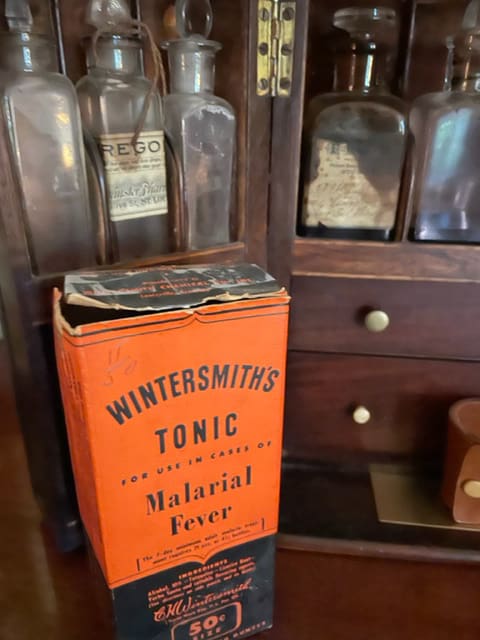
A "tonic" which was actually effective since it contained the antimalarial cinchona derivative, totaquine, which was very successfully utilized in the treatment of malaria. It was sold all over the world, wherever malaria existed.
Aunt Mary and Uncle Theo had a beautiful home on Cherokee Parkway just across from Cherokee Park.

Home of Red Robertson's aunt and uncle. He lived there later for the first 2 years while in medical school at the University of Louisville before transferring and graduating from Loyola University of Chicago in 1931.
Howard and I saw Red Roberts across the road kicking footballs. I'm not sure why he was in Louisville. Probably visiting someone who played on the team. Howard and I went over to the park and Red Roberts recognized me and called me his son and asked if we could retrieve his kicks and get the balls back to him which we gladly did. He was a hero to both Howard and me because Howard was going to enroll at Centre that fall, and we followed the football team already,
We ran at least 50 yards past him and he boomed a kick that sailed totally over our heads and hollered, “Son, you’d better back up a little. I’m hitting the ball awfully well today!”
Howard and I just looked at each other and couldn’t believe it. We knew he was an All-American, that Walter Camp had put him on his team. But we’d never actually seen him in action like kicking.
Now we understood.
I kept in contact with Red when I entered Centre in 1921, being his "son" and all. He helped me get to the 1922 Harvard game, but that's another story entirely. And then I really got to know him when he became the freshman team coach and he asked me to be the first-year team’s manager in the fall of 1924. We spent a lot time time together, and I always loved being Red Roberts' "son!"
( Red Roberts enrolled in Centre in 1918, staying at Centre for a 5th year due to having received an extra year of eligibility due to the war and influenza- shortened 1918 season. He was at Centre along with Red Robertson during the 1921-22 and 1922-23 school years and then in 1924 when he became the coach of the Lieutenants, Centre's freshman team. )
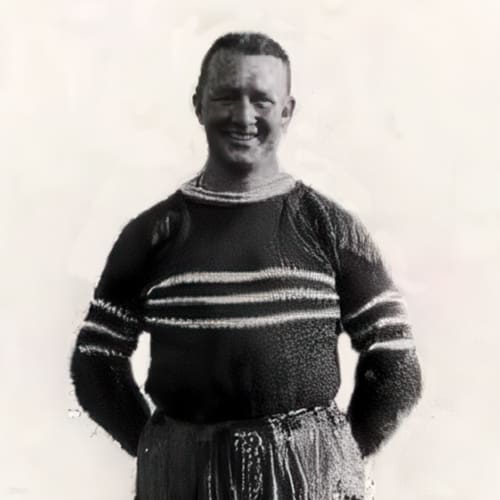
Red Roberts, Red Robertson's "dad"
